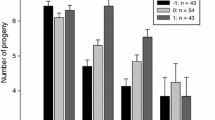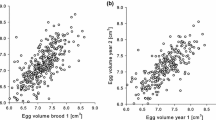Abstract
The reproductive trade-off hypothesis predicts that the investment made in current reproduction determines the breeders’ future fitness as a consequence of intra-or inter-generational reproductive costs. Long-lived species are expected to favour their own reproductive value at the expense of their offspring, hence incurring in inter-generational costs, whereas short-lived species are expected to invest in the current breeding attempt even at the expense of their own survival, thus incurring in intra-generational costs. We tested whether intensity of current reproductive effort has intra-or inter-generational costs in a short-lived bird, the blue tit Parus caeruleus, with a brood size manipulation experiment. We expected more intra-generational (parental reproduction and/or survival) than inter-generational (offspring quality and survival) reproductive costs. We found that parental effort, measured as the hourly rate of parental visits to nests, increased gradually with experimental manipulation. Brood size manipulation resulted in a gradual increase in the number of fledglings per nest from reduced to increased treatments. We found an effect of the manipulation on the probability of making a second clutch, with adults rearing enlarged broods being less likely to undertake such a second reproduction during the season compared to those rearing control or decreased broods. We found no evidence of other reproductive costs; neither as adult weight after manipulation, apparent parental local survival, apparent offspring local survival or local recruitment. Although the results seem to support the a priori expectations, alternative explanations are discussed.



Similar content being viewed by others
References
Askenmo C (1979) Reproductive effort and return rate of male pied flycatchers. Am Nat 114:748–753
Bell G, Koufopanou V (1986) The cost of reproduction. In: Dawkins R, Ridley M (eds) The Cost of Reproduction. Oxford University Press, Oxford, pp 83–131
Blondel J, Maistre M, Perret P, Hurtrez-Boussés S, Lambrechts MM (1998) Is the small clutch size of Corsican blue tit population optimal? Oecologia 117:80–89
Boyce MS, Perrins CM (1987) Optimizing great tit clutch size in a fluctuating environment. Ecology 68:142–153
Cramp S, Simmons KEL (eds) (1988) The Birds of the Western Palearctic, vol. V. Oxford University Press, Oxford
Daan S, Deerenberg C, Dijkstra C (1996) Increased daily work precipitates natural death in the kestrel. J Anim Ecol 65:539–544
Danchin E, Cam E (2002) Can non-breeding be a cost of breeding dispersal? Behav Ecol Sociobiol 51:153–163
Danchin E, Boulinier T, Massot M (1998) Breeding habitat selection based on conspecific reproductive success: implications for the evolution of coloniality. Ecology 79:2415–2428
Danchin E, Heg D, Doligez B (2001) Public information and breeding habitat selection. In: Clobert J, Danchin E, Dhondt AA, Nichols JD (eds) Dispersal. Oxford University Press, Oxford, pp 243–258
Danchin E, Giraldeau L-A, Valone TJ, Wagner RH (2004) Public information: from nosy neighbors to cultural evolution. Science 305:487–491
Deerenberg C, Penn I, Dijkstra C, Arkies BJ, Visser, GH, Daan S (1995) Parental energy expenditure in relation to manipulated brood size in the European kestrel Falco tinnunculus. Zoology 99:39–48
De Steven D (1980) Clutch-size, breeding success, and parental survival in the tree swallow (Iridoprocne bicolour). Evolution 34:278–291
Dijkstra C, Bult A, Bijlsma S, Daan S, Meijer T, Zijlstra M (1990) Brood size manipulations in the kestrel (Falco tinnunculus): effects on offspring and parent survival. J Anim Ecol 59:269–285
Doligez B, Danchin E, Clobert J, Gustafsson L (1999) The use of conspecific reproductive success for breeding habitat selection in a non-colonial, hole-nesting species, the collared flycatcher. J Anim Ecol 68:1–15
Drent RH, Daan S (1980) The prudent parent: energetic adjustments in avian breeding. Ardea 80:225–252
Fargallo JT, Merino S (1999) Brood size manipulation modifies the intensity of infection by Haematozoa in female Blue Tits Parus caeruleus. Ardea 87:261–268
Greenwood PJ (1980) Mating systems, philopatry and dispersal in birds and mammals. Anim Behav 28:1140–1162
Greenwood PJ, Harvey PH, Perrins CM (1979) The role of dispersal in the Great Tit (Parus major): the causes, consequences and heritability of natal dispersal. J Anim Ecol 48:123–142
Gustafsson L, Sutherland WJ (1988) The costs of reproduction in the collared flycatcher Ficedula albicollis. Nature 335:813–815
Harris MP (1966) Breeding biology of manx shearwaters. Ibis 108:17–33
Harris MP (1970) Breeding ecology of the swallow-tailed gull Creagrus furcatus. Auk 87:215–243
Hegner RE, Wingfield JC (1987) Effects of brood-size manipulations on parental investment, breeding success, and reproductive endocrinology of house sparrows. Auk 104:470–480
Hõrak P (2003) When to pay the cost of reproduction? A brood size manipulation experiment in great tits (Parus major). Behav Ecol Sociobiol 54:105–112
Hõrak P, Ots I, Murumagi A (1998) Haematological health state indices of reproducing Great Tits: a response to brood size manipulation. Funct Ecol 12:750–756
Jacobsen KO, Erikstad KE, Saether BE (1995) An experimental study of the costs of reproduction in the kittiwake Rissa tridactyla. Ecology 76:1636–1642
Jarvis MFJ (1974) The ecological significance of clutch size in the South African gannet (Sula capensis). J Anim Ecol 43:1–17
Kluyver HN (1951) The population ecology of the Great Tit, Parus major. Ardea 39:1–135
Klemp S (2000) Effects of parental effort on second brood, moult and survival in the Grey Wagtail Motacilla cinerea. Ardea 88:91–98
Korpimäki E (1988) Costs of reproduction and success of manipulated broods under varying food conditions in Tengmalm’s owl. J Anim Ecol 57:1027–1039
Lessells CM (1991) The evolution of life histories. In: Krebs JR, Davies NB (eds.), Behavioural ecology: an evolutionary approach. Blackwell, Oxford, UK, pp 32–68
Lindén M (1988) Reproductive trade-off between first and second clutches in the great tit Parus major: an experimental study. Oikos 51:285–290
Littell RC, Milliken GA, Stroup WW, Wolfinger RD (1996) SAS System for Mixed Models. SAS Institute, Cary, USA
Merilä J, Andersson M (1999) Reproductive effort and success are related to haematozoan infections in blue tits. Ecoscience 6:421–428
Merilä J, Wiggings DA (1997) Mass loss in breeding blue tits: the role of energetic stress. J Anim Ecol 66:452–460
Moreno J, Cowie RJ, Sanz JJ, Willians SRS (1995) Differential response by males and females to brood manipulations in the pied flycatcher: energy expenditure and nestling diet. J Anim Ecol 64:721–732
Moreno J, Sanz JJ, Arriero E (1999) Reproductive effort and T-lymphocyte cell-mediated immunocompetence in female pied flycatchers Ficedula hypoleuca. Proc R Soc Lond B 266:1105–1109
Nur N (1984a) The consequences of brood size for breeding blue tits I. Adult survival, weight change and the cost of reproduction. J Anim Ecol 53:479–496
Nur N (1984b) The consequences of brood size for breeding blue tits II. Nestling weight, offspring survival and optimal brood size. J Anim Ecol 53:497–517
Nur N (1988) The consequences of brood size for breeding blue tits III. Measuring the cost of reproduction, survival, future fecundity, and differential dispersal. Evolution 42:351–362
Orell M, Belda EJ (2002) Delayed cost of reproduction and senescence in the willow tit Parus montanus. J Anim Ecol 71:55–64
Orell M, Koivula K (1988) Cost of reproduction: Parental survival and production of recruits in the willow tit Parus montanus. Oecologia 77:423–432
Orell M, Koivula K, Rytkönen S, Lahti K (1994) To breed or not to breed: causes and implications of non-breeding habit in the willow tit Parus montanus. Oecologia 100:339–346
Orell M, Rytkönen S, Koivula K, Ronkainen M, Rahiala M (1996) Brood size manipulations within the natural range did not reveal intragenerational cost of reproduction in the willow tit Parus montanus. Ibis 138:630–637
Perrins CM, Moss D (1975) Reproductive rates in the great tit. J Anim Ecol 44:695–706
Pettifor RA, Perrins CM, McCleery RH (1988) Variation in clutch size in great tits: evidence for the individual optimalization hypothesis. Nature 336:160–162
Pettifor RA (1993a) Brood manipulations experiments. I. The number of offspring surviving per nest in blue tits (Parus caeruleus). J Anim Ecol 62:131–144
Pettifor RA (1993b) Brood-manipulation experiments. II. A cost of reproduction in blue tits (Parus caeruleus). J Anim Ecol 62:145–159
Reid WV (1987) The cost of reproduction in the glaucous-winged gull. Oecologia 74:458–467
Roff DA (1992) The evolution of life histories. Theory and analysis. Chapman & Hall, London, UK
Røskaft E (1985) The effect of enlarged brood size on the future reproductive potential of the rook. J Anim Ecol 54:255–260
Roulin A, Ducrest AL, Dijkstra C (1999) Effect of brood size manipulations on parents and offspring in the Barn Owl Tyto alba. Ardea 87:91–100
Rytkönen S, Orell M (2001) Great tits, Parus major, lay too many eggs: experimental evidence in mid-boreal habitats. Oikos 13:439–450
Saino N, Calza S, Ninni P, Moller, AP (1999) Barn swallows trade survival against offspring condition and inmunocompetence. J Anim Ecol 68:999–1009
Sanz JJ (1997) Clutch size manipulation in the Pied Flycatcher: effects on nestling growth, parental care and moult. J Avian Biol 28:157–162
Sanz JJ, Tinbergen JM (1999) Energy expenditure, nestling age, and brood size: an experimental study of parental behavior in the great tit Parus major. Behav Ecol 10:598–606
SAS (1999) SAS user’s guide. Version 8 edition. SAS Institute
Schjørring S, Gregersen J, Bregnballe T (2000) Sex difference in criteria determining fidelity towards breeding sites in the great cormorant. J Anim Ecol 69:214–223
Stearns SC (1992) The evolution of life histories. Oxford Univ Press, Oxford
Stjernman M, Raberg L, Nilsson JA (2004) Survival costs of reproduction in the blue tit (Parus caeruleus): a role for blood parasites? Proc R Soc Lond B 271:2387–2394
Sæther B-E (1989) Survival rates in relation to body weight in European birds. Ornis Scand 20:13–21
Tammaru T, Hõrak P (1999) Should one invest more in larger broods? Not necessarily. Oikos 85:574–581
Tinbergen JM (1987) Costs of reproduction in the great tit: intraseasonal costs associated with brood size. Ardea 75:111–122
Tinbergen JM, Both C (1999) Is clutch size individually optimised? Behav Ecol 10:504–509
Tinbergen JM, Daan S (1990) Family planning in the great tit (Parus major): optimal clutch size as integration of parent and offspring fitness. Behaviour 114:161–190
Tinbergen JM, Verhulst S (2000) A fixed energetic ceiling to parental effort in the great tit? J Anim Ecol 69:323–334
Velando A, Alonso-Alvarez C (2003) Differential body condition regulation by males and females in response to experimental manipulations of brood size and parental effort in the blue-footed booby. J Anim Ecol 72:846–856
Verhulst S 1995 Reproductive decisions in great tits. An optimally approach. Ph.D. Thesis, University of Groningen
Verhulst S, Hut RA (1996) Post-fledging care, multiple breeding and the costs of reproduction in the great tit. Anim Behav 51:957–966
Verhulst S, Tinbergen JM (1997) Clutch size and parental effort in the great tit Parus major. Ardea 85:111–126
Willians GC (1966) Natural selection, the costs of reproduction and a refinement of Lack’s principle. Am Nat 100:687–690
Acknowledgements
We thank all people who collaborated in data collection: M. Diot, A. Dreiss, I. Dworzynska, M. Geier, J. Pater, M. Xavier, J. White and many others. J. Avilés provided useful comments on the manuscript. Two anonymous referees also provided interesting suggestions to the manuscript. D. Parejo was supported by a Postdoctoral Marie Curie Fellowship (contract HPMF-CT-2000-00716). All procedures applied here comply with the French laws.
Author information
Authors and Affiliations
Corresponding author
Additional information
Communicated by M. Soler
Rights and permissions
About this article
Cite this article
Parejo, D., Danchin, E. Brood size manipulation affects frequency of second clutches in the blue tit. Behav Ecol Sociobiol 60, 184–194 (2006). https://doi.org/10.1007/s00265-005-0155-z
Received:
Revised:
Accepted:
Published:
Issue Date:
DOI: https://doi.org/10.1007/s00265-005-0155-z




